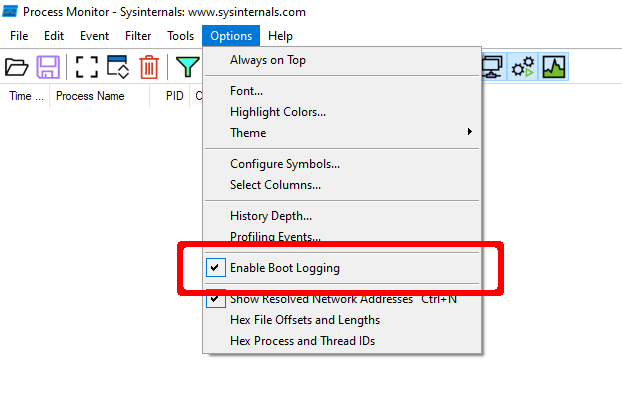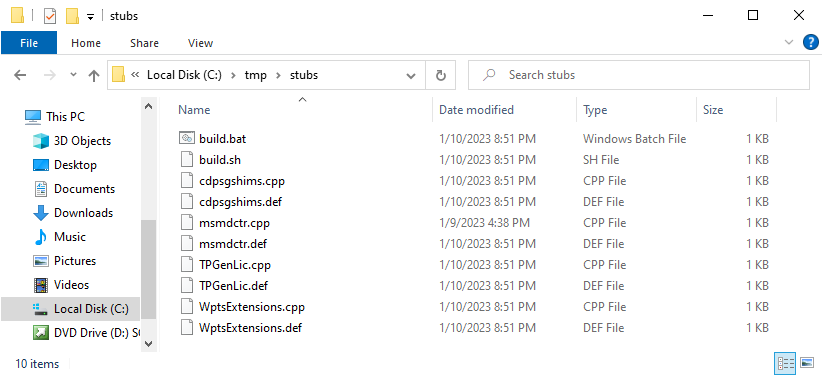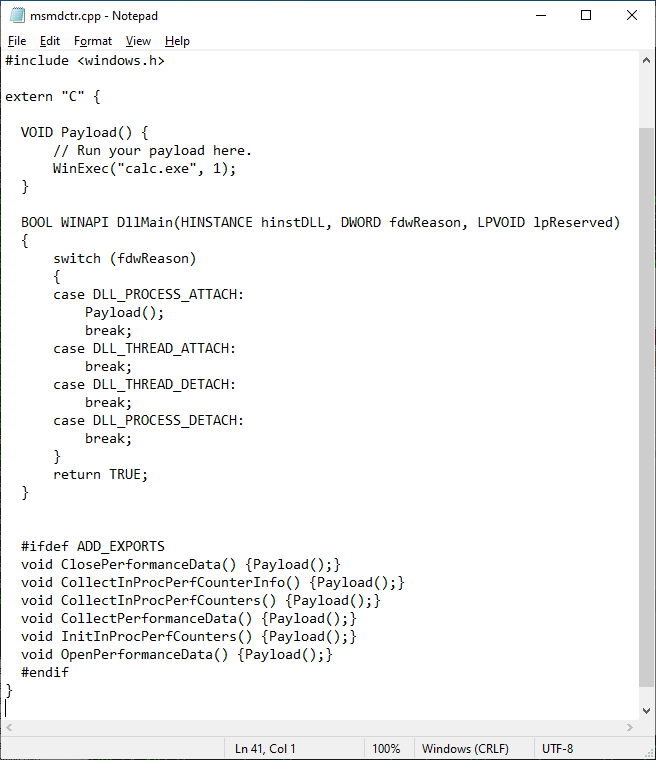- In Process Monitor, select the
Enable Boot Loggingoption.
- Reboot.
- Once you have logged in and Windows has settled, run Process Monitor once again.
- When prompted, save the boot log, e.g., to
raw.PML. - Reset the default Process Monitor filter using
Ctrl-R. - Save this log file, e.g., to
boot.PML. - Run
Crassus.exe boot.PML. - Investigate any green colored results and the corresponding entries in
results.csv.
- Why "Crassus"
- Screenshots
- Getting Crassus.exe
- Usage
- Compiling Proxy DLLs
- Real World Examples
- Troubleshooting
- Contributions
- Credits
Accenture made a tool called Spartacus, which finds DLL hijacking opportunities on Windows. Using Spartacus as a starting point, we created Crassus to extend Windows privilege escalation finding capabilities beyond simply looking for missing files. The ACLs used by files and directories of privileged processes can find more than just looking for missing files to achieve the goal.
...but with a twist as Crassus is utilizing the SysInternals Process Monitor and is parsing raw PML log files. Typical usage is to generate a boot log using Process Monitor and then parse it with Crassus. It will also automatically generate source code for proxy DLLs with all relevant exports for vulnerable DLLs.
- Parsing ProcMon PML files natively. The log (PML) parser has been implemented by porting partial functionality to C# from https://github.com/eronnen/procmon-parser/. You can find the format specification here.
- Crassus will create source code for proxy DLLs for all missing DLLs that were identified. For instance, if an application is vulnerable to DLL Hijacking via
version.dll, Crassus will createversion.cppandversion.deffiles for you with all the exports included in it. By default the proxy DLLs will launchcalc.exe. Build scripts are included to build the DLLs on Visual Studio or MinGW. - For other events of interest, such as creating a process or loading a library, the ability for unprivileged users to modify the file or any parts of the path to the file is investigated.
- Able to process large PML files and store all events of interest in an output CSV file.
The general gist of how Crassus works can be summarized in this flowchart:

Crassus was developed as a Visual Studio 2019 project. To build Crassus.exe:
- Open
Crassus.sln - Press
Ctrl+Shift+Bon your keyboard
If you trust running other people's code without knowing what it does, Crassus.exe is provided in this repository.
- In Process Monitor, select the
Enable Boot Loggingoption.
- Reboot.
- Once you have logged in and Windows has settled, optionally also run scheduled tasks that may be configured to run with privileges.
- Run Process Monitor once again.
- When prompted, save the boot log.
- Reset the default Process Monitor filter using
Ctrl-R. - Save this log file, e.g., to
boot.PML. The reason for re-saving the log file is twofold:- Older versions of Process Monitor do not save boot logs as a single file.
- Boot logs by default will be unfiltered, which may contain extra noise, such as a local-user DLL hijacking in the launching of of Process Monitor itself.
| Argument | Description |
|---|---|
<PMLFILE> |
Location (file) of the existing ProcMon event log file. |
--verbose |
Enable verbose output. |
--debug |
Enable debug output. |
Parse the Process Monitor boot log saved in boot.PML. All vulnerable paths will be saved as results.csv and all proxy DLL source files in the stubs subdirectory.
C:\tmp> Crassus.exe boot.PML
Below is the template that is used when generating proxy DLLs., For DLLs that are found by Crassus, the proxy DLL will contain the same export names as specified in %_EXPORTS_%, as well as the same ordinals as specified in the .def file. Crassus will detect whether the DLL needs to be built as a 32-bit library or a 64-bit library by looking at the architecture of the parent process, and tagging the source code in the %_BUILD_AS_% field accordingly.
If the real DLL cannot be found using the Process Monitor log, or if the export name is problematic, the build scripts will fall back to creating a DLL without specified exports.
#pragma once
//%_BUILD_AS%
#include <windows.h>;
extern "C" {
VOID Payload() {
// Run your payload here.
WinExec("calc.exe", 1);
}
BOOL WINAPI DllMain(HINSTANCE hinstDLL, DWORD fdwReason, LPVOID lpReserved)
{
switch (fdwReason)
{
case DLL_PROCESS_ATTACH:
Payload();
break;
case DLL_THREAD_ATTACH:
break;
case DLL_THREAD_DETACH:
break;
case DLL_PROCESS_DETACH:
break;
}
return TRUE;
}
#ifdef ADD_EXPORTS
%_EXPORTS_%
#endif
}For applications that unsafely use the OPENSSLDIR variable value, a crafted openssl.cnf file can be placed in the noted location. For this example, the software will load C:\tmp\calc.dll. Be sure to use a 32-bit library to target 32-bit processes, and a 64-bit library to target 64-bit processes.
[openssl_init]
# This will attempt to load the file c:\tmp\calc.dll as part of OpenSSL initialization
# Build scripts should detect whether the calc.dll library needs to be built as 32-bit or 64-bit
/tmp/calc = asdf
Compilation is possible using the cl.exe binary included with Visual Studio. Specifically:
cl.exe /DADD_EXPORTS /D_USRDLL /D_WINDLL <target>.cpp /LD /Fe<target>.dll /link /DEF:<target>.def
To automate the build process, including specifying whether the library should be 64-bit or 32-bit:
- Open the Visual Studio Developer Command Prompt.
- Build the DLLs with the
build.batscript. - Rename the compiled file as necessary if the vulnerable file name ends with something other than
.dll.
Note: Due to an unfortunate behavior with vcvarsall.bat, which is definitely not a bug, you may encounter trouble attempting to run build.bat more than once in the same Visual Studio Developer Command Prompt session. If you encounter an error, simply close the window and launch it again.
If Visual Studio isn't readily available, proxy DLLs can be compiled with MinGW-w64 instead. On an Ubuntu platform for example, MinGW can be installed via the following: sudo apt install g++-mingw-w64-x86-64-win32 g++-mingw-w64-i686-win32
# Create a 32-bit DLL
i686-w64-mingw32-g++ -c -o <target>.o <target>.cpp -D ADD_EXPORTS
i686-w64-mingw32-g++ -o <target>.dll <target>.o <target>.def -s -shared -Wl,--subsystem,windows
# Create a 64-bit DLL
x86_64-w64-mingw32-g++ -c -o <target>.o <target>.cpp -D ADD_EXPORTS
x86_64-w64-mingw32-g++ -o <target>.dll <target>.o <target>.def -s -shared -Wl,--subsystem,windows
To automate the build process, including specifying whether the library should be 64-bit or 32-bit:
- Open a terminal.
- Run
bash ./build.sh - Rename the compiled file as necessary if the vulnerable file name ends with something other than
.dll.
As outlined in VU#114757, older Acronis software contains multiple privilege escalation vulnerabilities.
- Placement of
openssl.cnfin a unprivileged-user-creatable location. - Inappropriate ACLs in the
C:\ProgramData\Acronisdirectory.
Crassus finds both of these issues automatically.

By planting our compiled curl.dll file in the C:\ProgramData\Acronis\Agent\var\atp-downloader\ directory and rebooting with a new Process Monitor boot log we can see that our payload that runs calc.exe runs, with SYSTEM privileges.

The vulnerable Acronis software attempts to load openssl.cnf from two different locations. We'll place our template openssl.cnf file in c:\jenkins_agent\workspace\tp-openssl-win-vs2013\17\product\out\standard\vs_2013_release\openssl\ssl, and a 32-bit calc.dll payload in c:\tmp.

As outlined in VU#240785, older Atlassian Bitbucket software is vulnerable to privilege escalation due to weak ACLs of the installation directory. As with any Windows software that installs to a location outside of C:\Program Files\ or other ACL-restricted locations, it is up to the software installer to explicitly set ACLs on the target directory.
Crassus finds many ways to achieve privilege escalation with this software, including:
- Placement of missing DLLs in user-writable locations.
- Placement of missing EXEs in user-writable locations.
- Renaming the directory of a privileged EXE to allow user placement of an EXE of the same name.
In the Crassus output, we can see that c:\atlassian\bitbucket\7.9.1\elasticsearch\bin\elasticsearch-service-x64.exe is privileged, but since it's running we cannot simply replace it. However, we can use another trick to hijack it. We may be able to simply rename the directory that it lives in, create a new directory of the same name, and plant our payload there as the same name.

Once we reboot with a Process monitor boot log, we can see that our planted elasticsearch-service-x64.exe file is running instead of the real one, based on the Windows Calculator icon.

As outlined in VU#287178, older versions of McAfee software are vulnerable to privilege escalation via openssl.cnf. Let's have a look:

To see why there are two different references to openssl.cnf in this boot log, we can refer to the results.csv file:

Note that the loading of the openssl.cnf file from the D:\ path will require further manual investigation, as the feasibility of loading such a path depends on the platform in question, and what access to the system is available. It may be possible to create an optical disk that provides an openssl.cnf file that also refers to a path that resolves to the optical drive as well.
SQL Server 2022 isn't obviously vulnerable to privilege escalation due to weak ACLs unless it is installed to a non-standard location. If it is installed to a location outside of C:\Program Files, Crassus will uncover several possibilities for privilege escalation. Most Windows applications that include a privileged component appear to be exploitable in this manner if they are installed to a directory that doesn't already have inherently secure ACLs.

If Crassus reports the privileged loading of a file that a user can plant or modify, this doesn't necessarily mean that it's an exploitable scenario. While Crassus looks for potentially interesting file types, a Process Monitor log file will not directly indicate what the associated process would have done with the file with it if it were there. It could be as simple as extracting a program icon. Investigating the call stack of the file operation in Process Monitor may give a hint as to what would have been done. Or simply place the file and investigate the behavior with a new Process Monitor boot log, if you prefer the easier brute force path. You may also encounter a missing library where either Crassus cannot find the library to know what exports should be present, or that the exports that Crassus found conflict in a way that prevents proper DLL compilation. In such cases, Crassus will fall back to creating a DLL that does not export any function names. Depending on how the target application loads the library, the absence of expected function names and/or ordinal numbers may prevent the target application from successfully loading the library. This scenario will require manual effort to determine what the proxy DLL should look like.
Crassus will look for privileged file operations to discover paths of interest. You may encounter a scenario where both a privileged and an unprivileged process access a path, but only the non-privileged process is the one that does the execution of what may be present. Alternatively, you may encounter a scenario where a parent process does run with privileges, but it may explicitly spawn child processes with lower privileges.
Especially when installing software for the first time, or when installing updates, Process Monitor may log a file operation that looks to be exploitable but does not occur every time that the system boots. Exploiting these operations may be possible on the first reboot after such an event happens. To avoid such edge cases, confirm that subsequent boot logs contain the same reported file operations on subsequent reboots.
Whether it's a typo, a bug, or a new feature, Crassus is very open to contributions as long as we agree on the following:
- You are OK with the MIT license of this project.
- Before creating a pull request, create an issue so it could be discussed before doing any work as internal development is not tracked via the public GitHub repository. Otherwise, you risk having a pull request rejected if for example we are already working on the same/similar feature, or for any other reason.





